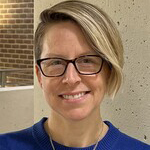Advanced Studies in Teaching and Learning
Register for an Upcoming Information Session
Upcoming Events
Advance your career and strengthen your impact with a 100% online, flexible master’s degree tailored to your interests.
Are you ready to grow as an equity-oriented, critically reflective teacher leader? Our graduates have the skills to consider and respond to the multiple and varied social, cultural, and linguistic factors influencing their teaching and their students’ learning. Engage in advanced study within your professional interests —expand your content area expertise, broaden your understanding of teacher leadership, explore how culture and school climate impact student development, and much more!
Students in this program earn a Master of Education in Curriculum and Instruction in Advanced Studies in Teaching and Learning. You may design your own individualized area of focus or choose from 5 defined concentrations.
- Individualized
- Diversity and Exceptionality in PK-12 Schools
- Physical Education
- Science, Technology, Engineering, and Mathematics (STEM)
Not seeking a master's degree but seeking VDOE add-on licensure endorsement in Gifted Education? Check out the Graduate Certificate in Gifted Education under Graduate Options.
Learn more about our Graduate Certificate in Learning Technologies, Concentration in Designing Digital Learning in Schools.
Who is this degree for?
ASTL is designed for working educators. Whether you’re a new teacher or an experienced educator, utilize your school and classroom setting as a professional learning laboratory.
This is not an initial licensure program. If you are interested in a teacher licensure program, click here.
Where will this degree take you?
- Become a research-oriented, student-centered teacher leader whose teaching practice is aligned with the Five Core Propositions of the National Board for Professional Teaching Standards (NBPTS).
- Expand your understanding of how students learn, how to design instruction that meets the needs of all learners in your classroom, and how to assess student learning through multiple approaches.
- Engage in research in your own classroom and school related to how cultural and linguistic factors affect students' learning and school environment.
- Build leadership skills to become an equity-forward change agent in your school community.
- Develop your expertise in a content area of choice that deepens your professional knowledge and identifies you as a team and building leader.
- Specific coursework leads to opportunities for VDOE add-on endorsements or International Baccalaureate certification.
What is curriculum and instruction?
Curriculum and Instruction is a field within education that encompasses the study of teaching and learning, including curriculum design, instructional methods, models, strategies, and educators’ professional practices within their classrooms, schools, and districts. The field focuses on the variety of ways that people learn, how teachers develop as educators, and how innovation in education can be leveraged to improve teaching and learning.
Why study curriculum and instruction at Mason?
- 15% discount for Virginia educators
- Strong alumni network
- Designed for teachers and refined by graduates – alumni advise ASTL faculty on program updates and work with faculty in professional development endeavors
- World-class faculty at an accessible cost
- Study at Virginia’s largest and most diverse university
- Flexible schedule
- Scholarships available, including the Joan Isenberg Scholarship for ASTL students
Find out more about courses and admissions for each concentration under Graduate Options.
All students who apply to the MEd in Curriculum and Instruction in Advanced Studies in Teaching and Learning are automatically processed into the Individualized concentration. Upon admission, students may declare a different concentration or remain in the Individualized concentration.
Note: If you visited this page prior to Fall 2023, you will notice a difference in our concentration offerings. If you have questions about how this may affect your intended application, please contact a program representative.




